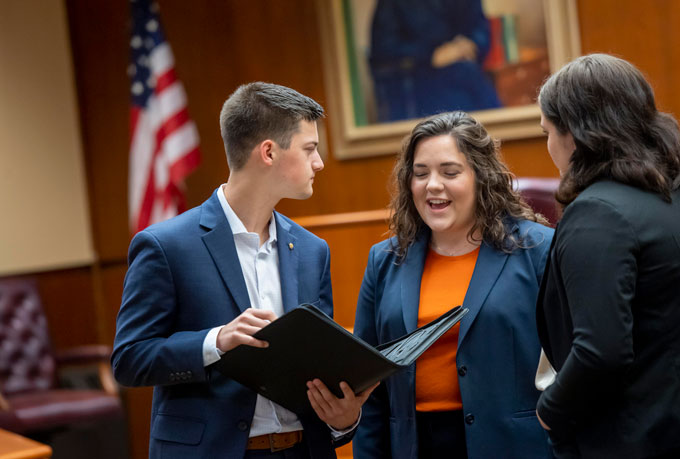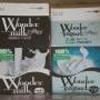Beijing, Day 2

We woke up to a rainy Tuesday morning at the Jin Ma Hotel in the Haidian District of Beijing. Since we were about to go to the US Embassy, we had to wake and eat earlier than usual because of morning rush hour and required security procedures. Fortunately our tour guide, Jane, was able to arrange for us to still get breakfast before our departure.
We boarded our bus at 7 AM and were pleasantly surprised by less traffic than expected since we had actually beaten the rush hour.We were also glad to see blue skies for the first time since arrival. After waiting for our escort into the embassy to submit our passports and acquire visitor badges for all 24 people in our group, we entered the compound after having left all electronic devices (cellphones, cameras, video equipment, etc.) back on the bus, an embassy stipulation. `
Eric Trachtenberg, the Director of the Agricultural Trade Office, and Mark Petry, the Agricultural Attache, presented a talk about agricultural trade relations and policies within China. Trachtenberg gave an overview of what he considered the eight current mega-trends that China is currently experiencing.One of the most significant mega-trends was that of Urban Migration -- people living in rural areas migrating towards urban locales.The effects of this trend are that there are less farmers, an increase in the middle class, and an increase in income. Petry expanded on the foreign trade policies of how the US is trying to increase American exports to Chinese markets.He added that the agricultural issues that Trachtenberg mentioned were going to increase the exports from the US to China as well. He stressed that the United States wants to increase exports to China in order to maintain political stability, as well as increase the amount of jobs available for Americans.The other main reason was that the US is trying to make China comfortable with the United States as a trade partner. Trachtenberg further explained that United States' law prohibits the export of a commodity meant for human consumption if it is not of good enough quality to be consumed within the U.S.
After a lengthy Q & A session, we left feeling very well-informed on the role of the United States' government within international agricultural trade policies.
Lunch was served at a local seafood restaurant, the Peace Harbor. Joining us was Eugene Chen, the Technical Program Manager for the U.S. Grains Council in Beijing. We were able to try some popular dishes that most visitors to the country instantly fall in love with: YuXiangRouSi or Fish-Flavoured Chicken, tomatoes and eggs, a Chinese version of fried Chicken, and some others which were very delicious.Just as our meal was concluding, we were able to witness the preparation of a roasted hanging goose, and it sparked our curiosity about what tomorrow night's Peking Roast Duck meal will be like!
The afternoon brought us about 60 km from the city to HuaXia Dairy Farm. On the ride to the farm, Eugene gave us a talk on the background of the Chinese dairy industry, along with an introduction to the farm we were about to visit. We knew we had arrived when an enormous cow statue on top of a gateway appeared.Due to bio-security concerns, we were all promptly sanitized with UV lights prior to entering the farm. CEO Charles Shao greeted us and gave us an overview of his farm, how it differed from other Chinese dairy farms, and its goals for the future. The dairy began in 2004 with 180 Holstein cows imported from New Zealand. Today, HuaXia Dairy Farm houses over 6,600 cows with plans to expand further. Unlike many Chinese dairy farms, HuaXia Dairy Farm focuses first and foremost on quality. It is one of the few Chinese dairy farms to use pasteurization as opposed to Ultra-High Temperature processing. There are two main destinations that the milk they produce goes towards. It is distributed at select stores within the Beijing area under the Wonder Milk brand. Additionally, they sell a percentage of their milk to other dairy companies to blend with other milk to increase the quality of milk from other dairies. A very important fact to note about HuaXia is that they believe in sharing information about technology and best practices in a type of open platform with other companies through training sessions. Mr. Shao also talked about how he found himself in the dairy business after a long career in Information Technology. He talked about when he used to travel around China and there were two things that the Chinese people avoided. Those two things were tap water and milk.After witnessing this, Shao wanted to make milk a product the Chinese people trusted and was given the opportunity to do this when he went to work at HuaXia Dairy. We also watched a clip made by CCTV, a government-owned television station, in which it emphasized many of the different characteristics that make HuaXia not the typical dairy farm in China.Following the video, we were greeted with an unexpected surprise. A veterinarian who graduated from the University of Illinois stopped in to talk with us. He worked for TransOva and was at the dairy farm that day to do embryo transfer work on some of the cows.
We sampled some of the dairy's milk, which was delicious as expected. Dr. Rung-Syin Tung then took us on a short tour through the facilities on a bus. He explained the different management practices of the farm, showed us the employee dormitory, and also informed us that all of their hay is imported from California. Dr. Tung described the herd as an "international herd," with cattle imported from New Zealand and bred with genetics from the United States. It was very cool to drive around and see the 6,600 cows that called the dairy home. They were truly living a life of luxury with warm beds made of sand and food always available.
After the farm we boarded the bus and started heading back to the city. By the time we had reached the edge of the city we were driving through a furious thunderstorm. Luckily, the storm did not last long enough to ruin our plans. Eventually we made it to our destination, the Silk Market.We were first impressed by the size of the market, which was six floors high. The market was an interesting experience of Chinese culture. As we walked inside the market, we were overwhelmed with all the booths selling everything imaginable.As we walked through the aisles, the booth attendants invited us over to look at their goods. In contrast to stores in the U.S., the price of everything is negotiable. This was a truly unique and new experience for almost everyone as they tried their hand at bartering. By the time we left, many of us were able to buy souvenirs for our families and friends after lengthy haggling with the vendors.After the market, our group went to a Korean style restaurant where we enjoyed many different styles of dishes.
